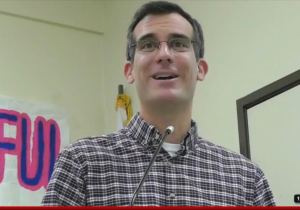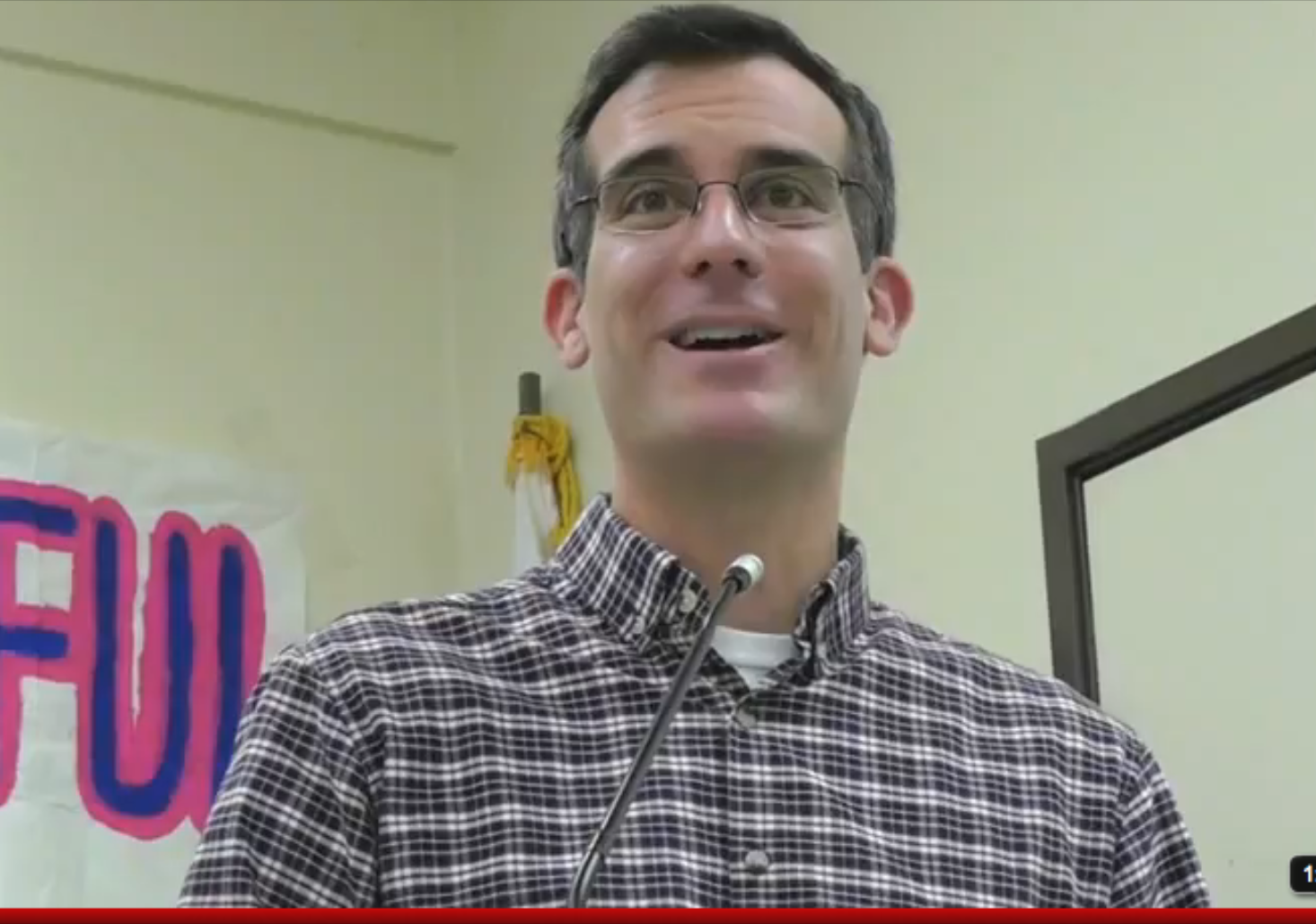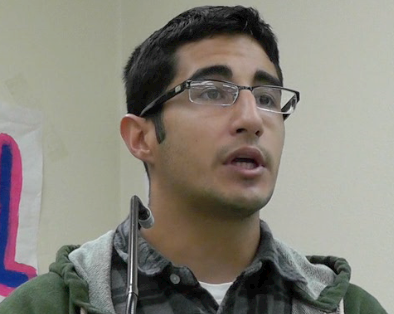
Los Angeles City Council President Eric Garcetti shares his personal experience with "the long-term cost of living cheaply in the short term." Paul Laverack / El Nuevo Sol.
POLITICAL MUSCLE
This is a short series of videos, showcasing several speakers at the “RePower LA” community meeting, at Pacoima Community Center on Saturday, November 5, 2011. “RePower LA” is a coalition of civil society organizations dedicated to creating green jobs in Los Angeles, by using public policy to move the city toward sustainable energy.
Ricardo De Los Santos discusses his work weatherizing low-income homes as part of the Utility Pre-Craft Trainee position created by the Los Angeles DWP and the International Brotherhood of Electrical Workers.
“With the help of the union, and the DWP, I got this opportunity,” De Los Santos says. “I’m working with a great company with great benefits.”
The benefits are not only for him, however. “This program has been very helpful for me, for my colleagues, and for the customers. They’re very happy with the stuff we do. It helps them out in the long run, as far as having cheaper bills. We’re hoping we can continue doing this.”
Los Angeles City Council President Eric Garcetti shares his personal experience with “the long-term cost of living cheaply in the short term,” discussing his family’s battles with cancer which related to their living near freeways as he was growing up. He points out that what seems cheap today, as leaded gasoline did in those days, often comes with hidden costs to our families and communities, which become tragically clear years later.
Garcetti is upbeat about the prospects for RePower LA. Due to solutions like theirs, Garcetti says, “We will be living not only more inexpensively, but also healthier, longer lives.”
Kent Minault, volunteer coordinator for the Sierra Club’s Beyond Coal campaign in Los Angeles, discusses several aspects of the city’s present coal-power situation.
Minault examines the reasons behind the recent spike in coal prices, and the proven efficiency-enhancing methods which could make it possible to get off coal in the near term. “Energy efficiency,” Minault says, “is the most important source of energy we’ve got!”
Minault points out the difference between energy conservation and energy efficiency, calling our buildings made in the past seventy years or so “energy stupid.”
Minault closes by naming current legislative initiatives which he thinks are essential to moving forward with green energy innovation, and he emphasizes to the attendees the importance of expressing their wishes to their elected representatives. “They need to know we have their backs.”
Finally, appearing below are the full remarks of Los Angeles Department of Water & Power general manager Ron Nichols. The Los Angeles DWP is the largest publicly-owned utility in the United States.
Nichols talks about the changing priorities at DWP, away from what costs the least in the short run, to what will cost the city the least in the longer term. He repeatedly discusses increasing investment in energy efficiency, which he calls the number one job creator locally, for the DWP.
He admits that the DWP has been slow in the past to invest in such programs as the current Utility Pre-Craft Trainee – he explains the reasons why investor-owned utilities have historically been faster to invest in similar efforts – though he stresses that DWP is taking a different approach now. “We are making a huge change.”
A theme running through Nichols’s remarks is the DWP’s need to have a budget sufficient to creating energy-efficiency programs. While these programs, like the Utility Craft Pre-Trainee, will create long-term benefits, there are short-term costs to implementing them. Nichols never states this outright, but as he explains where the DWP budget comes from, it becomes clear that electricity rates will have to go up.
Nichols provides an example of how pricing can be used to incentivize behavior. He implies that higher night-time rates can be used as one inducement to encourage businesses to cut back on their overnight lighting usage. He is quick to add, however, that more efficient equipment is another element in that solution.
During earlier remarks at the same event, the LA City Council president cautioned residents to be less concerned with their rates than with the bottom line cost of their bills. Both Garcetti and Nichols recognize that the per-unit cost of electricity is likely to rise as the department mounts ambitious plans toward sustainability.
However, the overall cost of energy to the consumers can still drop dramatically – as residents use less. Nichols explains that the DWP has a mandate to reach 10% savings from efficiency by the year 2020, while the Sierra Club’s Kent Minault cites a Los Angeles study which found savings as high as 40% are feasible.
The tension between rising per-unit cost and falling overall prices is the tightrope walk that Nichols needs to balance successfully if Los Angeles is going to move toward greener, more sustainable energy in the future. “To fund more programs like the Pre-Craft Trainee,” Nichols points out, “we need to get some additional budget.”
Nichols is emphatic, “I want to make clear to everyone in this room – LA DWP wants to put more money into these programs. It is our number one priority.”
Nichols closes by stressing the need for concerned citizens to push their elected officials to make the right moves. “They need cover,” Nichols says. “They need to know their constituents want this.”
Tags: beyond coal California dwp eric garcetti green energy green jobs ibew kent minault laane Los Angeles Pacoima Pacoima Beautiful repower la ricardo de los santos ron nichols San Fernando Valley sierra club



















